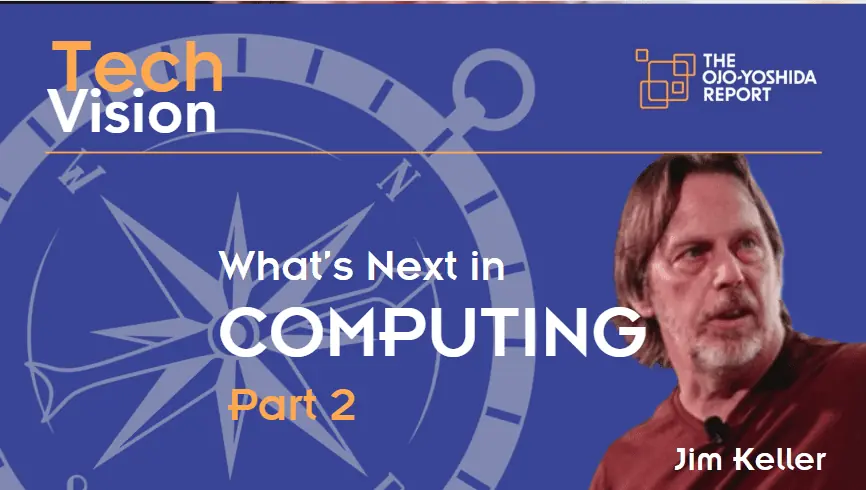
What two big trends does Jim Keller, Tenstorrent CEO, see in next-generation computing?
As the sheer volume of computation keeps growing to millions or trillion operations per second, what are the changes – in both in hardware and software — that have to happen?
Why did Tenstorrent choose RISC-V for its CPU architecture?
Is the computing industry today stuck in local optimization?
Jim Keller’s video podcast — What’s Next in Computing Part 2 — has answers to all of the above. And more.
Philosophy of science
Keller asked me during the interview, “Are you into the philosophy of science?”
The question completely stumped but delighted me. It’s the sort of a question that can be only asked by an electrical engineer who attempted to get a double major in philosophy.
If you want to work on innovative new products, you must work hard to make sure you’re not trapped by your own thinking and ideas.
Jim Keller
Two books Keller recommends: “The Structure of Scientific Revolution” by Thomas Kuhns, and “Against Method” by Paul Feyerabend. Kuhns warns that scientific paradigms tend to ignore information and phenomena outside their paradigm (Keller pointed out, “The world’s smartest scientists and physicists all [once] believed the Earth was the center of the universe”), while Feyerabend wrote in his book that it’s not just that paradigms that ignore outside information. “But they can’t even see it … everything humans do becomes a little world in and of itself, and they actively reject change,” Keller explained.
Why do these books matter? Keller explains, “If you want to work on innovative new products, you must work hard to make sure you’re not trapped by your own thinking and ideas.”
On open source
In Keller’s view, “The stack of technology today is very big and diverse.” But what makes things interesting is open source.
“There are things that are open source … like physics, math, Linux, LLaMA (Large Language Model Meta AI) model and RISC-V architecture standard,” observed Keller.
In contrast, proprietary technology too often leads to dead ends. Historically speaking, the mainframe computer era petered out, in Keller’s opinion, because it was built mostly on proprietary technologies. “Those companies [who developed proprietary technologies] stopped innovating because they had captive customers,” he noted.
Keller said, “RISC-V is a computer architecture standard that’s published. Our company, Tenstorrent, built a RISC-V processor, which is very fast. That’s proprietary. So [you need to understand] those are two different things.”
AI models are adding new wrinkles, though. Keller said, “Because you could have thought that PyTorch is the language you write it in, and that’s open, while the LLaMA model could have been proprietary. But for complicated reasons, the LLaMA model is open.”
Today, companies can use LLaMA to build business and services, because not everybody knows how to program in PyTorch, said Keller.
So, the layers of technology are literally changing what we had thought should be open or shouldn’t. “It’s very interesting,” said Keller.
Innovation not for the innovation’s sake
Meanwhile, Keller offered one of the most cogent messages to his fellow innovators. “If your goal is innovation, it’s not going to work out.”
He stresses, “Your goal in life has to be able to make a product that somebody wants and that solves a real problem.” Which is what Tenstorrent is committed to doing.
One question frequently asked of Keller, is, “How do you compete with Nvidia?” Nvidia is a “very good company, and Jensen is a brilliant technologist and business person,” Keller conceded.
But Keller has often heard from customers who say, “I want to build my own product. I want to own my technology. I’m interested in RISC-V. I would like to license the AI IP. I want a partner to go build that product. I want to see a demonstration of the software and AI hardware, because it’s very difficult. … many people have built a hardware that didn’t work, or the software that didn’t work.”
Responding to this wish-list, Tenstorrent’s business model ranges from licensing technology, helping customers design and showing them how to use RISC-V and AI, to building its own chips and chiplets.
As a result, Tenstorrent is finding “a lot of business opportunities.” Keller said. During the interview, he said he enjoys “when we have a good customer who’s smart, because they give you lots of interesting feedback. And if they know what they want, and they’re pushing very hard, you get in this kind of positive feedback loop of ‘we work hard to meet their needs.’”
Don’t forget to watch the Part 1 of our conversation with Jim Keller.
Junko Yoshida is the editor in chief of The Ojo-Yoshida Report. She can be reached at [email protected].
Copyright permission/reprint service of a full TechSplicit story is available for promotional use on your website, marketing materials and social media promotions. Please send us an email at [email protected] for details.
